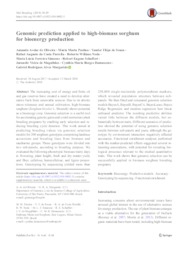Genomic prediction applied to high-biomass sorghum for bioenergy production.
Genomic prediction applied to high-biomass sorghum for bioenergy production.
Author(s): OLIVEIRA, A. A. de; PASTINA, M. M.; SOUZA, V. F. de; PARRELLA, R. A. da C.; NODA, R. W.; SIMEONE, M. L. F.; SCHAFFERT, R. E.; MAGALHAES, J. V. de; DAMASCENO, C. M. B.; MARGARIDO, G. R. A.
Summary: The increasing cost of energy and finite oil and gas reserves have created a need to develop alternative fuels from renewable sources. Due to its abiotic stress tolerance and annual cultivation, high-biomass sorghum (Sorghum bicolor L. Moench) shows potential as a bioenergy crop. Genomic selection is a useful tool for accelerating genetic gains and could restructure plant breeding programs by enabling early selection and reducing breeding cycle duration. This work aimed at predicting breeding values via genomic selection models for 200 sorghum genotypes comprising landrace accessions and breeding lines from biomass and saccharine groups. These genotypes were divided into two sub-panels, according to breeding purpose. We evaluated the following phenotypic biomass traits: days to flowering, plant height, fresh and dry matter yield, and fiber, cellulose, hemicellulose, and lignin proportions. Genotyping by sequencing yielded more than 258,000 single-nucleotide polymorphism markers, which revealed population structure between subpanels. We then fitted and compared genomic selection models BayesA, BayesB, BayesC?, BayesLasso, Bayes Ridge Regression and random regression best linear unbiased predictor. The resulting predictive abilities varied little between the different models, but substantially between traits. Different scenarios of prediction showed the potential of using genomic selection results between sub-panels and years, although the genotype by environment interaction negatively affected accuracies. Functional enrichment analyses performed with the marker-predicted effects suggested several interesting associations, with potential for revealing biological processes relevant to the studied quantitative traits. This work shows that genomic selection can be successfully applied in biomass sorghum breeding programs.
Publication year: 2018
Types of publication: Journal article
Unit: Embrapa Maize & Sorghum
Keywords: Bioenergia, Biomassa, Genotipagem
Observation
Some of Embrapa's publications are published as ePub files. To read them, use or download one of the following free software options to your computer or mobile device. Android: Google Play Books; IOS: iBooks; Windows and Linux: Calibre.
Access other publications
Access the Agricultural Research Database (BDPA) to consult Embrapa's full library collection and records.
Visit Embrapa Bookstore to purchase books and other publications sold by Embrapa.

